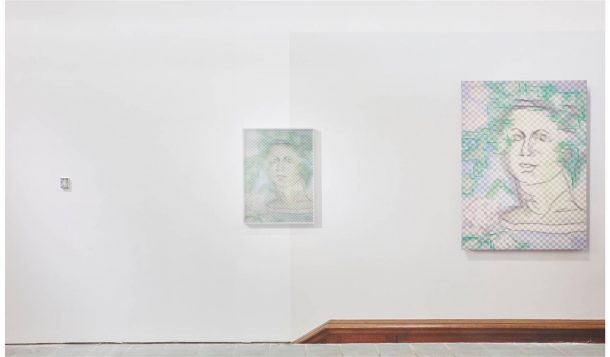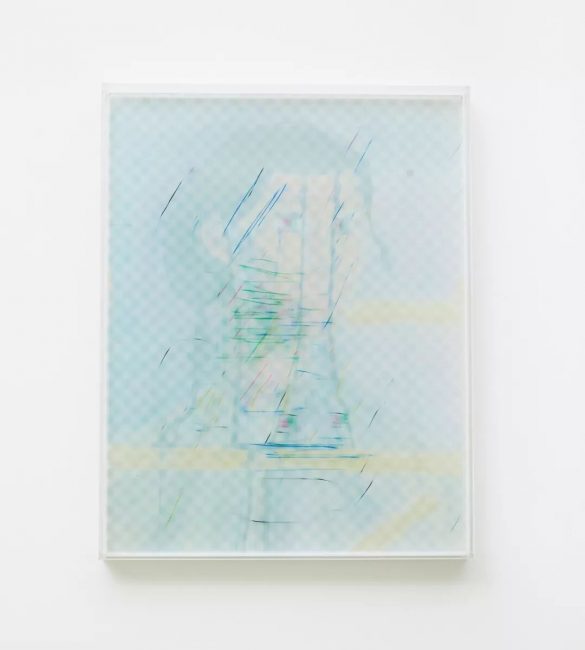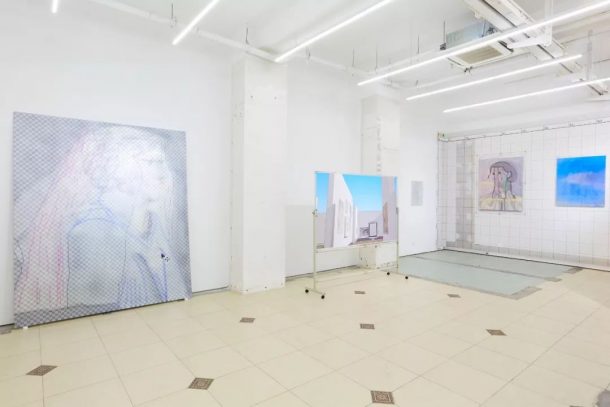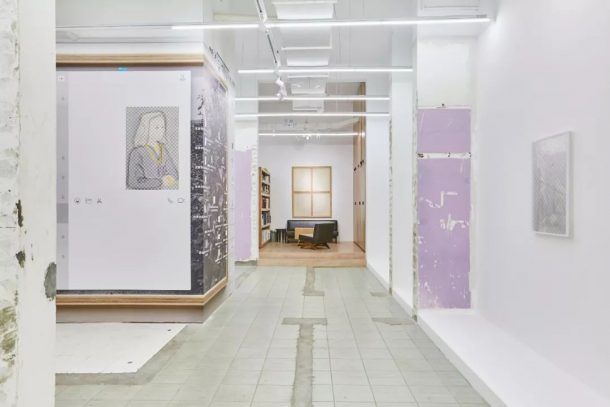The Virtual Shadow of Lin Ke’s Sky Painting
| 2019年09月12日
In “Sky Painting,” Lin Ke’s second solo exhibition at the BANK gallery, two different uses of the word “icon” appear in one place: the icon of the desktop and the icon of iconography. Lin’s previous work has established his signature style of images and video work created from the desktop of a 2008 MacBook, yet in this exhibition computers seem to make way for a study of mostly religious figures, and a preoccupation with metaphysical questions. “Sky Painting” mainly consists of UV prints on acrylic, aluminum, and silk of digitized watercolor paintings, which depict figures as varied as the Virgin Mary, a Daoist xian (i.e. supreme being), King Kong, and the artist himself. The colors of the images are dissected and printed onto different layers of a thick transparent acrylic sheet, set against a backdrop of the white and grey checkerboard pattern that signifies transparencies on a computer screen. The virtual and actual transparencies are thus pushed against one another, creating a mesmerizing uncanniness where faintly discernible colors delineate half present figures. “I am inspired by the Tibetan Buddhist Fuzang. A line of texts would appear in the sky, and Fuzang would see it and write it down,” Lin explains. Not only does the artist take spiritual inspiration from the sky, the ultraviolet ray of light that he prints with almost seems to come from above too.

Some compositions might not be easy to recognize at a glance, but upon investigation one finds, for example, the Virgin Mary and Child, an image that dates back to the second century. During the medieval era, paintings of the Madonna usually avoided portraying her as life-like in order to separate the dimensionless divine world with the physical mundane one. Perspective was usually inaccurate, and only the shadowing created a sense of volume, as in this image, which serves only as a conduit or interface; it is not a representation of divinity. Like a desktop, the surface draws you in with a sense of volume, but ultimately its flatness reminds you that it is of a different dimension (an immaterial world, for an immaterial girl!). Lin Ke expands such iconography to include Daoist cosmology, as well as a female cyborg figure inside the Adobe Photoshop interface. It seems like the screen is now the conduit between the mundane physical world and the digital immaterial world. The “virtual,” a word that used to designate the immaterial, such as memory (the past) and possibilities (the future), has become fully synonymous with “digital.”

UV print on acrylic, 47 x 60 cm
The exhibition defamiliarizes our sense of physical qualities, of transparency, shadow, weight, size, and space, by juxtaposing the virtual with the actual. Winter Triangle, for example, presents three versions of the same watercolor image of the cyborg figure. At first, one might think there are three prints, two of which are hanging against a backdrop of a Photoshop window printed as wallpaper. A closer look reveals that the image in the middle titled “Artificial Intelligence.jpg” is actually a weightless part of the wallpaper, given an illusionary sense of layer and individuality by the shadowing of the Mac OS interface. Right next to it, the same composition is printed with UV light on a solid piece of aluminum plate, hanging on the wall in all its literal weightiness.

By zooming in on the digital form of physical qualities, Lin Ke furthers his investigations of desktop imagery and delves into its metaphysics—questioning what exists and what does not. The actually transparent acrylic is put in actually transparent spaces, set against the virtually transparent pattern. The checkerboard pattern is often used to signify on-screen transparency, a visual nothingness, during the production of an image. By printing it on a physical surface, he asks us to look at how this signifier of an image’s absence is an image itself. Transparency is in fact all around us, in the air we breathe, but a computer must invent an image to represent it.

This iconographic study of the digital does not set aside Lin Ke’s old preoccupations, rather it puts them under more nuanced examination. The subtle presence of desktop cursors reminds us not only of the digital process of making artwork and an exhibition, but also its later circulation as digital documentation, through which it registers symbolically/historically. When you open the installation shots of this exhibition on your desktop, you suddenly find two cursors on your screen: one yours and the other the artist’s. The video piece Model in the exhibition is an installation shot of a work that does not exist in a physical space, with a cursor moving ever-so-slightly over the face of the figure. After the role of artists moved from simply producing artwork to examining the practice of exhibiting and the act of installing it, it is perhaps the logical next step to investigate the further supplementary process of the digital documentation and circulation of art. When images enter the virtual world, all physicality is left behind, their weight eliminated, their size adjustable, and only a virtual shadowing resurrected. One day, when we have nothing left of ourselves but images, will they too have shadows?

